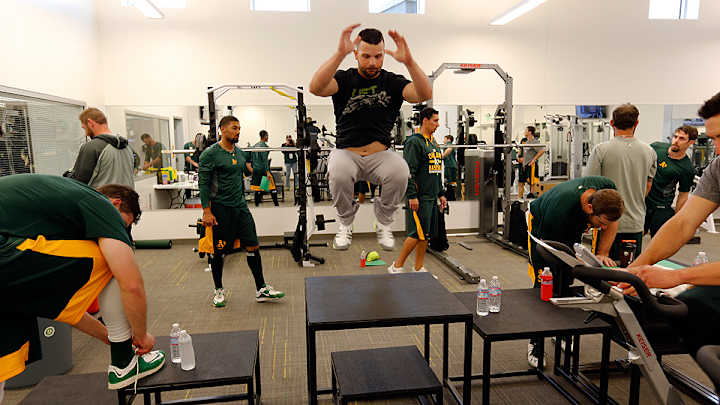Tech Talk: How Volt is looking to make pro-level training available to all

Boyd Epley has been called the "Godfather of Strength and Conditioning." As the University of Nebraska’s head strength coach for 35 years, the founder of the National Strength and Conditioning Association and, since October, the Huskers’ assistant athletic director for strength and conditioning, overseeing the department he helped build, Epley has witnessed the evolving landscape of athletic training.
Now, as players and coaches fight for dominance in a world becoming increasingly focused on efficient, high-tech training methods, Epley sees a lack of qualified trainers for high schools, colleges and mismatched programs that make the process difficult for athletes.
That’s why Epley decided to serve as chairman of the board for Volt, a company started by Dan Giuliani, a sports performance professor from the University of Washington. To date, Volt has partnered with the likes of USA Football and the National Strength and Conditioning Association, bringing tailored training programs to schools that need the assistance.
The problem
Go to your local high school. You may find a strength coach training athletes. But you may also find a well-intentioned math or music teacher—not a certified trainer—overseeing the program.
Even if high schools and colleges do have certified people developing and running strength programs, Epley says he routinely gets called in to assist in situations where multiple coaches are spread out across a variety of sports in one school, giving their athletes completely different styles of programming “with competing philosophies.”
“That ends up impacting the facility,” Epley says about how resources get utilized. “The [athletic director] is always looking what best practices are, they want to do the right thing,” he says.
The program
To offer solutions to the problems facing many schools around the country, Epley says, Volt replaces the need for a strength coach, helping schools who don’t have the luxury of employing someone certified in sport-specific athletic training. Volt can “tailor to the needs of an athlete individually or a group,” by using a certified strength and conditioning specialist—the highest certification in the industry—to develop programs and create versatility for teams and athletes.
Training with Greg Jennings: CrossFit-inspired workouts fuel the Miami WR
Using those certified specialists, Seattle-based Volt creates programs for schools by matching a plan to the athletic department and their facilities.
Epley says strength and conditioning requires three key pieces to reach successful outcomes: a facility, a program and proper supervision of that program. “Volt is trying to come in and offer the best program to have at the facility matched up to it,” he says. “Right now Volt is getting expertise brought to their level.”
By choosing a program and exercises that both work with the equipment available and within a facility’s physical space, Volt tries to best utilize what a school already has to serve the greatest number of athletes.
The impact
High schools and smaller college programs, where strength coaches aren’t always in the budget, have gravitated towards Volt to allow for greater flexibility in their sports training programs. However, bigger schools, such as Nebraska, Michigan and Georgia Tech, have also showed interest in the ability to tailor training programs to each of their sports and athletes.
The program has also given a boost to female athletes around the country. As Epley explains, even today female sports—whether high school or college—sometimes still get the short end of the stick when it comes to resources and access, with their male counterparts getting the best time of the day for training, the best coaches and sometimes even better facilities.
Using statistics from Volt, Epley says women are training at the same rate as men: “Volt has a tremendous impact, brining up the quality of strength and conditioning for females" to the same level as males, according to Epley.
What’s next for Volt?
Volt has already started moving toward more versatility in its programs, which will help it serve the major Division I programs, Epley says. Version 2.0, which launches later in 2015, accentuates this. Fixed programs work at the high school and small college level, but Epley says at Nebraska, for example, he needs the ability to change the program. If he wants to create a new baseball-specific warm-up for players off campus during Christmas, he wants the flexibility to let certified coaches do their own programming.
In the second version, a coach, for example, can give a quarterback a different program than a lineman, but track them out of the same dashboard. At the same time, coaches can swap movements, change frequency, rename programs and put athletes with injuries on rehab programs.
Volt 2.0 also puts the program on the move, allowing coaches to make changes and for athletes to receive their instructions and step-by-step visuals on their phone or tablet in a customizable platform.
Through his new role at Volt, Epley looks to help shape yet another shift in the world of strength and conditioning.
Tim Newcomb covers stadiums, design and gear for Sports Illustrated. Follow him on Twitter at @tdnewcomb.
